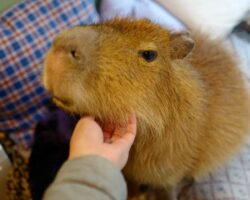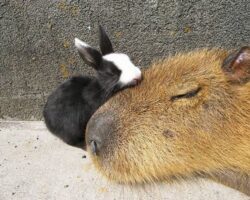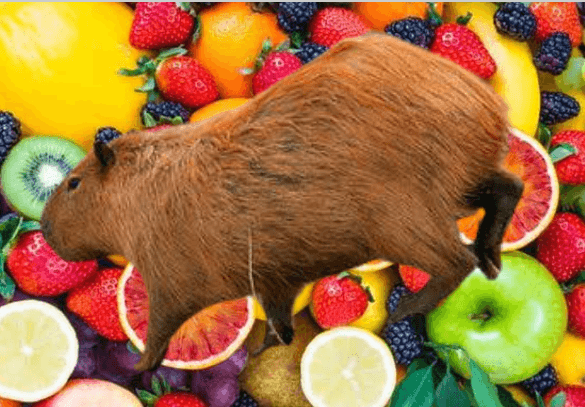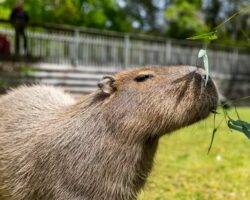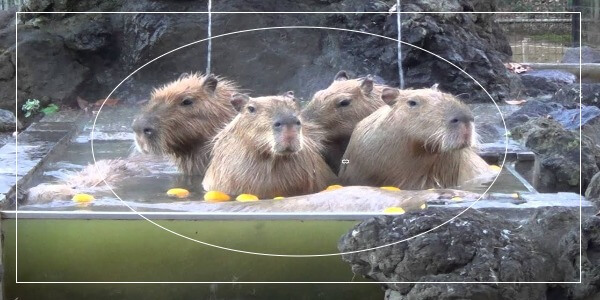Looking for the world’s largest rodent? Search for the capybara. The capybara (Hydrochoerus hydrochaeris) is the largest rodent on the planet. A capybara can easily be mistaken for a guinea pig due to its gigantic size.
These creatures are believed to come from South America. They could be found in the grasslands of forests of Brazil, Columbia, Argentina, Uruguay, Peru, etc.
They stay in dense forests, especially close to lakes, swamps, rivers, ponds, marshes, and water bodies in general. Capybaras are semi-aquatic, meaning they can stay in water and on land. Their webbed toes and feet help them swim and run as fast as 35 km/h on land.
Capybaras are not solitary creatures, they form large social groups known as “herds” which sometimes contain 10 to 20 or more capybaras. On average, a capybara can live for eight to ten years.
They feed on a whole lot of things, from grasses to water plants, tree bark, fruits, and vegetables. Capybaras are friendly and less hostile to one another. They are playful, social, and highly productive. Also, they have different communication methods to alert themselves of danger and protect themselves when necessary.
These intelligent rodents have been spotted away from South America. The capybaras were first seen in Florida in the ‘90s. Lots of capybaras can be seen in Florida, but no one knows how they got there.
It is assumed they escaped from a small zoo or may have immigrated on their own. Today, capybaras are common to find in Florida and many cities in the U.S. because they are kept as pets.
Now that you have known where capybaras originated from, it would be great to know some capybaras facts.
Interesting Capybara Facts You Should Know
| Name | Capybara |
| Specie | Hydrochoerus hydrochaeris |
| Class | Herbivores |
| Habitat | Near marshes, plants, rivers, ponds, swamps & tropical rivers |
| Location | South America (Except Chile), North America |
| Lifespan | 8 – 10 years |
| Size | 106 – 134cm |
| Weight | 35 – 66kg |
| Color | Brown |
| Diet | Grasses, tree bark, fruits, vegetables, and aquatic plants |
| Predators | Jaguars, pumas, caimans, green anacondas |
| Top Speed | 35 kph |
| No. of Species | 1 |
| Conservation Status | Low concern |
1. They Are The World’s Biggest Rodent
This is one of the common capybara facts. The capybara is the largest rodent known to man. If you think the beaver or guinea pig is the biggest rodent, then you are wrong.
Typically, a capybara can weigh anywhere between 75 to 150 pounds. On average, they can weigh from 35 to 66 kg. Adult capybaras are twice the size and weight of North American beavers. The biggest capybara ever recorded in history weighed 91kg (201 lbs).

Also, they measure between 3.5 to 4.4 feet in length and their size is similar to that of a small canine.
2. They Are Two Species of Capybara
There are two different species of capybara. One of them is the Hydrochoerus hydrochaeris, which is the largest and most popular capybara and the other is the Hydrochoerus isthmius, the lesser capybara.
The lesser capybara is the smallest of the two breeds. This particular capybara species is found in Columbia and Panama and they weigh around 60 to 80 pounds.
3. Capybaras Are Related To Guinea Pigs
When you see a capybara, you may think they are giant guinea pigs. These rodents are closely related to each other, as they belong to the Caviidae (Cavy family), which is made of up over fourteen different rodent species native to South America, including capybaras, guinea pigs, etc.
4. They Are Semi-Aquatic Animals
Capybaras love staying in places where they can find nearby water sources. So when you see a capybara in the wild, you can be sure there is plenty of other capybaras in the environment, and there is a pool of water nearby.
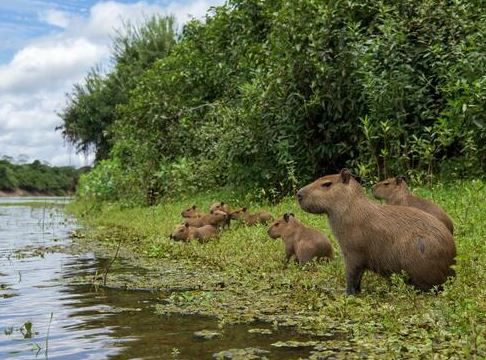
Obviously, capybaras love water and they enjoy swimming especially when it is hot. They have webbed toes that help them paddle and swim with ease.
Capybaras find it comfortable to stay where they can access water bodies such as lakes, rivers, swamps, and marshes. Their bodies are designed to thrive on land and in water. Their thick brown fur dries quickly when they leave the water.
Capyabaras do a lot of activities underwater. They can take a nap and pass the night while in water. Surprisingly, the capybara can mate in water, which is great for females who aren’t in the mood. If a female capybara isn’t ready to mate with a male capybara, she leaves the water.
So, the male has no other option than to look for another female capybara to mate with.
5. They Can Sleep In Water
Capybaras can submerge themselves underwater and even sleep in the water. These rodents will leave their noses out on the edges of riverbanks to allow them to draw in and expel air.
Capybaras can hold their breath underwater for over five minutes. They do this to hide from the sights of predators in the wild.
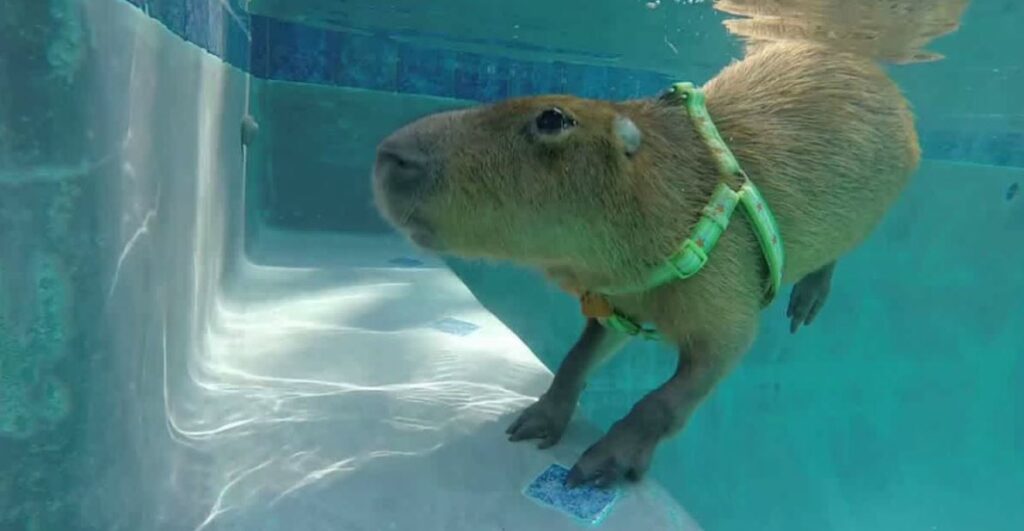
Like many other semi-aquatic animals, the capybara’s ears, eyes, and nose are sensitive and are positioned high on their heads to help them detect predators while on land and water. They can see, breathe, and hear while their bodies are submerged underwater.
6 They are Highly Sociable Creatures
Capybaras love living in groups of 10 to 20 members. The numbers can increase to 40, 50, or up to 100 capybaras in the herd. Capybara are highly sociable and find it easy to bond and relate with each other.
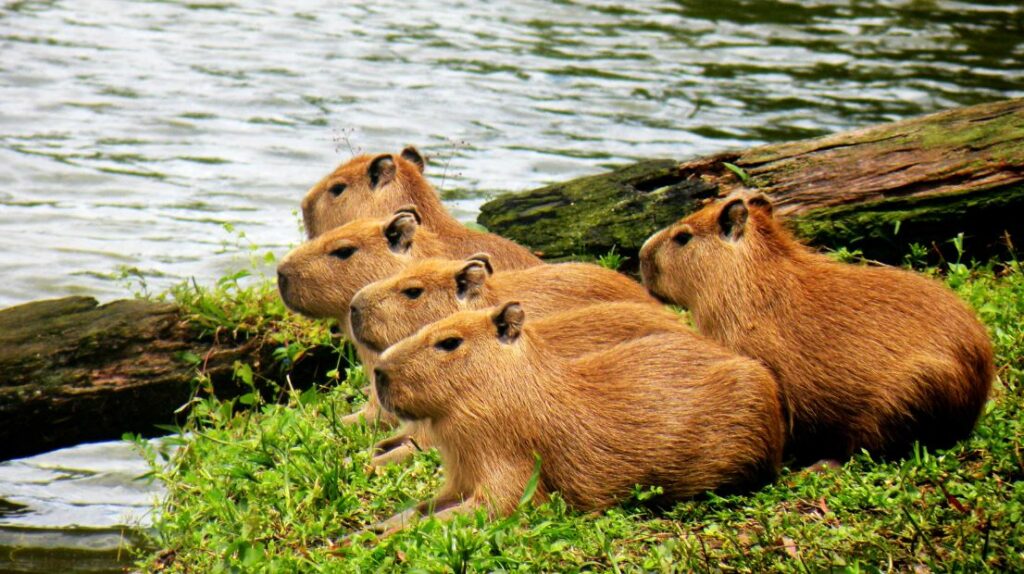
The male capybaras are rigidly hierarchical and compete among themselves for almost everything, including females, food, power, dominance, etc. The males also help defend the females and the rest of the herd when endangered.
The females on the other hand are highly cooperative, they mate with the males and help nurse, wean, and protect the young ones.
7. Other Animals Ride or Sit On Them
Capybara provide a soft, chilling spot for other animals. Capybaras are not only friendly and social with themselves but with other animals as well.
Animals such as monkeys, rabbits, and birds love sitting and riding on the back of capybaras. In turn, the birds will search and eat pests in the capybara’s fur.
8. They Are Eaten By Several Predators
Young and adult capybaras can make a juicy and satisfying meal for several predators in the jungle. Prowling predators such as anacondas, pumas, jaguars, ocelots, eagles, caracaras, and caimans love eating capybaras.
The adult capybara has the responsibility of looking after their young as they can be attacked from any area, including land, air, and water.
Capybaras typically seek refuge inside the water bodies to hide from predators such as pumas, ocelots, jaguars, and others. However, they have to be careful of anacondas while submerged in water.
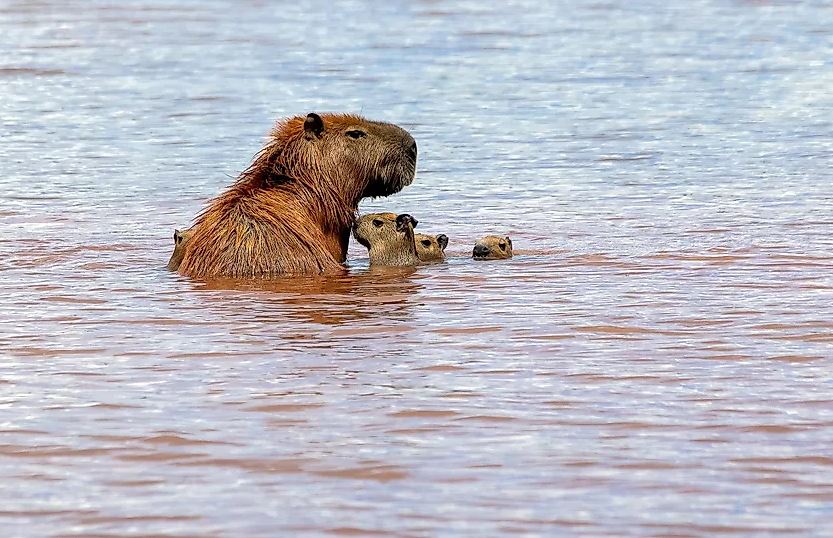
9. They Are Fast
Capybaras are extremely swift and fast. Their partially webbed toes help them paddle themselves and swim quickly. On land, they can run as fast as 35 kph.
10. They Have Long, Sharp Teeth
Capybaras have long teeth which help them chop and chew fruits, grasses, tree barks, etc. They also use their sharp teeth as a weapon when threatened. Their teeth keep growing for the rest of their lives.
11. They Are Selective About Their Diet
While the capybara primarily feeds on grasses and leaves, it doesn’t eat all the green plants in the jungle. They use their strong sense of smell to find nutritious plants and vegetables. When they find good vegetation, they tend to focus on it and avoid other plants around it.
12. They Eat Their Own Poop
Capybaras are autocoprophagous because they eat their own waste. Feasting on their bacteria-filled feces helps them digest cellulose and re-absorb nutrients in the plant matter.
13. They Can Be Affected With Scurvy
Like humans and other mammals, the capybara body system does not produce vitamin C. Therefore, they need to have sufficient qualities of vitamins in their diet.
Insufficient intake of vitamin C will cause them to suffer from scurvy. Capybaras can eat citrus fruits such as lemons, yuzu, and oranges to help them get sufficient qualities of vitamin C extracts in their body.
14. They Can Be Kept as Pets
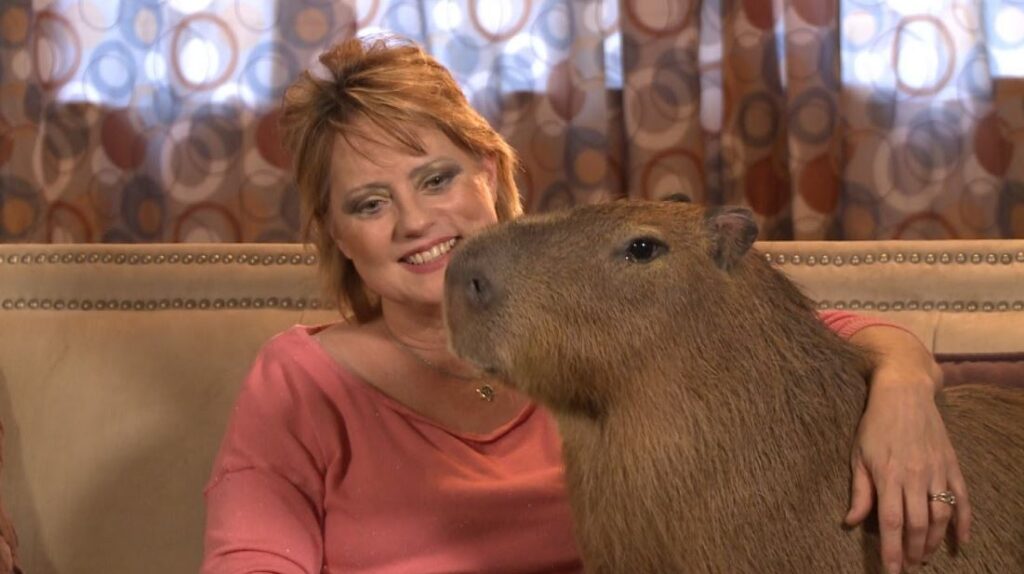
Although the capybara lives in the wild, people are beginning to keep them as pets in their homes. If you are wondering about keeping these exotic pets in your home, yard, or garden, be sure to know if it is legal to own a capybara in your state or region.
Additionally, if the laws in your locality permit capybara ownership, be sure to check the requirements and follow the guidelines.
15. They Give Birth To Multiple Babies
Female capybaras give birth to multiple babies at once. Sometimes, they can give birth to over 8 babies. This is one of the strong reasons why these rodents are yet to go extinct. Read our post on capybaras’ reproduction facts to see how capybaras produce their offspring.
16. Capybaras Are Endangered
The size of capybaras makes them a befitting meal for both humans and animals. These rodents are poached and hunted for their skin and meat, endangering their population and existence.
At the moment, the capybara population is believed to be stable. However, measures should be taken by the government and organizations to see that these rodents do not go into extinction.

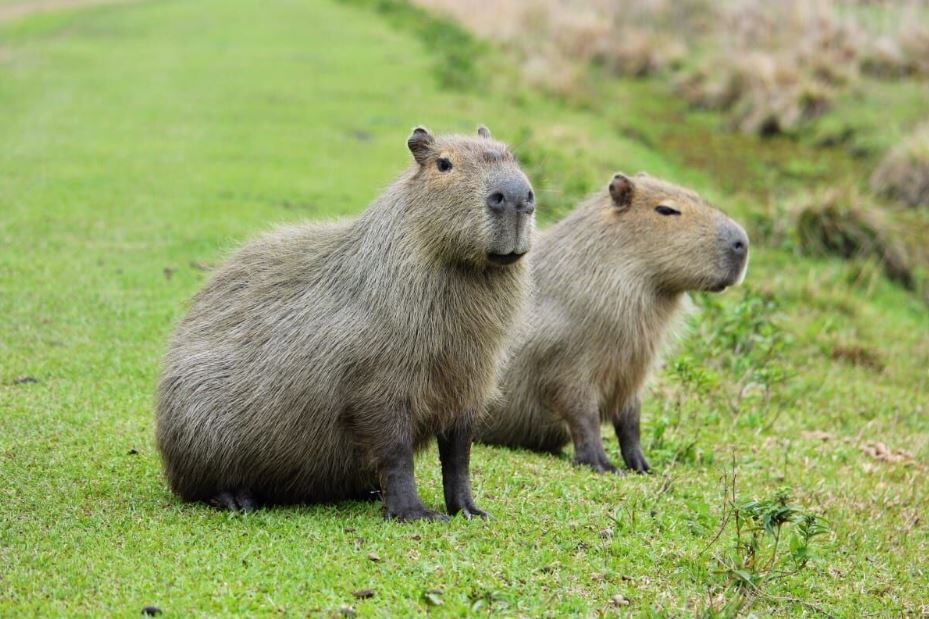
![Capybara Meat And Its Culinary Uses - [Every You Should Know] Capybara Meat & Culinary Uses](https://capybaratips.com/wp-content/uploads/2023/03/Capybara-meat-250x200.webp)

